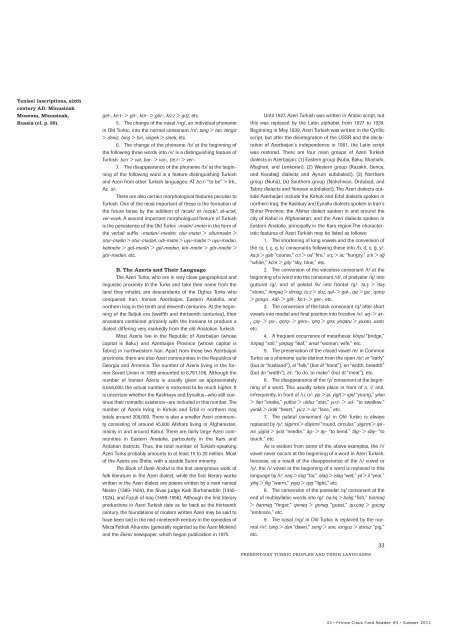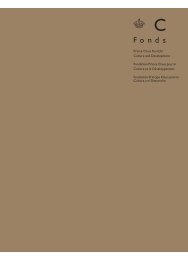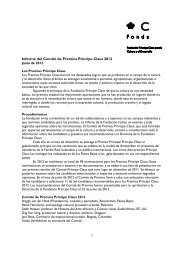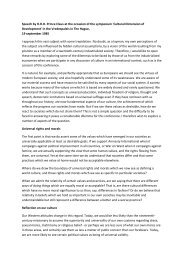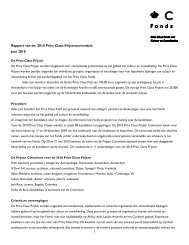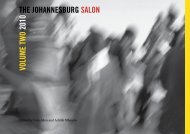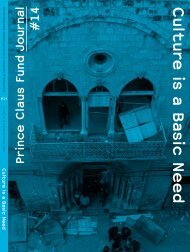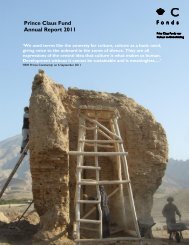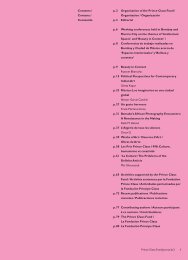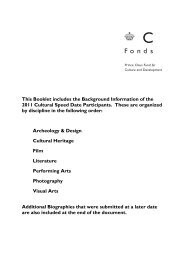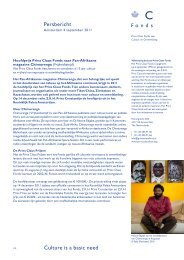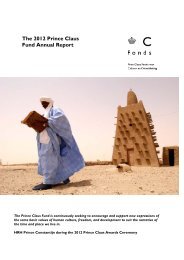3 summer 2011 - Prince Claus Fund
3 summer 2011 - Prince Claus Fund
3 summer 2011 - Prince Claus Fund
- No tags were found...
Create successful ePaper yourself
Turn your PDF publications into a flip-book with our unique Google optimized e-Paper software.
030–053talattekin_alt:turklergaram 29.11.2007 9:21 Uhr Seite 33Yenisei inscriptions, sixthcentury AD. MinusinskMuseum, Minusinsk,Russia (cf. p. 30).gel-, ke:t- > git-, kör- > gör-, kü:z > güz, etc.5. The change of the nasal /ng/, an individual phonemein Old Turkic, into the normal consonant /n/; tang > tan, tengiz> deniz, bıng > bin, singek > sinek, etc.6. The change of the phoneme /b/ at the beginning ofthe following three words into /v/ is a distinguishing feature ofTurkish: ba:r > var, bar- > var-, be:r- > ver-.7. The disappearance of the phoneme /b/ at the beginningof the following word is a feature distinguishing Turkishand Azeri from other Turkish languages: AT bo:l- “to be” > Trk.,Az. ol-.There are also certain morphological features peculiar toTurkish. One of the most important of these is the formation ofthe future tense by the addition of /acak/ or /ecek/; al-acak,ver-ecek. A second important morphological feature of Turkishis the persistence of the Old Turkic -matin/-metin in the form ofthe verbal suffix -madan/-meden; olur-matın > olturmadın >otur-madın > otur-madan, udı-matın > uyu-madın > uyu-madan,kelmetin > gel-medin > gel-meden, kör-metin > gör-medin >gör-meden, etc.B. The Azeris and Their LanguageThe Azeri Turks, who are in very close geographical andlinguistic proximity to the Turks and take their name from theland they inhabit, are descendants of the Oghuz Turks whoconquered Iran, Iranian Azerbaijan, Eastern Anatolia, andnorthern Iraq in the tenth and eleventh centuries. At the beginningof the Seljuk era (twelfth and thirteenth centuries), theirancestors combined primarily with the Iranians to produce adialect differing very markedly from the old Anatolian Turkish.Most Azeris live in the Republic of Azerbaijan (whosecapital is Baku) and Azerbaijan Province (whose capital isTabriz) in northwestern Iran. Apart from these two Azerbaijanprovinces, there are also Azeri communities in the Republics ofGeorgia and Armenia. The number of Azeris living in the formerSoviet Union in 1989 amounted to 6,791,106. Although thenumber of Iranian Azeris is usually given as approximately6,646,000, the actual number is reckoned to be much higher. Itis uncertain whether the Kashkays and Eynallus—who still continuetheir nomadic existence—are included in this number. Thenumber of Azeris living in Kirkuk and Erbil in northern Iraqtotals around 200,000. There is also a smaller Azeri communityconsisting of around 45,000 Afshars living in Afghanistan,mainly in and around Kabul. There are fairly large Azeri communitiesin Eastern Anatolia, particularly in the Kars andArdahan districts. Thus, the total number of Turkish-speakingAzeri Turks probably amounts to at least 15 to 20 million. Mostof the Azeris are Shiite, with a sizable Sunni minority.The Book of Dede Korkut is the first anonymous work offolk literature in the Azeri dialect, while the first literary workswritten in the Azeri dialect are poems written by a man namedNesim (1369-1404), the Sivas judge Kad› Burhaneddin (1345-1524), and Fuzuli of Iraq (1498-1556). Although the first literaryproductions in Azeri Turkish date as far back as the thirteenthcentury, the foundations of modern written Azeri may be said tohave been laid in the mid-nineteenth century in the comedies ofMirza Fethali Ahundov (generally regarded as the Azeri Molière)and the Ekinci newspaper, which began publication in 1875.Until 1927, Azeri Turkish was written in Arabic script, butthis was replaced by the Latin alphabet from 1927 to 1939.Beginning in May 1939, Azeri Turkish was written in the Cyrillicscript, but after the disintegration of the USSR and the declarationof Azerbaijan’s independence in 1991, the Latin scriptwas restored. There are four main groups of Azeri Turkishdialects in Azerbaijan: (1) Eastern group (Kuba, Baku, Shamah›,Mughan, and Lenkoran), (2) Western group (Kazakh, Gence,and Karaba€ dialects and Ayrum subdialect), (3) Northerngroup (Nuha), (4) Southern group (Nahchivan, Ordubad, andTabriz dialects and Yerevan subdialect). The Azeri dialects outsideAzerbaijan include the Kirkuk and Erbil dialects spoken innorthern Iraq; the Kashkay and Eynallu dialects spoken in Iran’sShiraz Province; the Afshar dialect spoken in and around thecity of Kabul in Afghanistan; and the Azeri dialects spoken inEastern Anatolia, principally in the Kars region.The characteristicfeatures of Azeri Turkish may be listed as follows:1. The shortening of long vowels and the conversion ofthe /p, t, ç, q, k/ consonants following these into /b, d, c, €, y/:ka:p > gab “course,” o:t > od “fire,” a:ç > ac “hungry,” a:k > ağ“white,” kö:k > göy “sky, blue,” etc.2. The conversion of the voiceless consonant /t/ at thebeginning of a word into the consonant /d/, of postvelar /q/ intoguttural /g/, and of palatal /k/ into frontal /g/: ta:ş > daş“stone,” tırngaq > dırnag, tu:z > duz, qal- > gal-, qız > gız , qonşı> gonşu , käl- > gäl-, ke:t- > get-, etc.3. The conversion of the back consonant /q/ after shortvowels into medial and final position into fricative /x/: aq- > ax-, çıq- > çıx-, qorq- > gorx-, qırq > gırx, yoqaru > yuxarı, uxarı,etc.4. A frequent occurrence of metathesis: körpü “bridge,”torpag “soil,” yarpag “leaf,” arvat “woman, wife,” etc.5. The preservation of the closed vowel /e/ in CommonTurkic as a phoneme quite distinct from the open /ä/: er “early”(but är “husband”), el “folk” (but äl “hand”), en “width, breadth”(but än “width”), et- “to do, to make” (but ät “meat”), etc.6. The disappearance of the /y/ consonant at the beginningof a word. This usually takes place in front of /›, i/ and,infrequently, in front of /u, ü/: yıp > ip, yigit > igid “young,” yılan> ilan “snake,” yultuz > ulduz “star,” yu:t- > ud- “to swallow,”yüräk > üräk “heart,” yü:z > üz “face,” etc.7. The palatal consonant /g/ in Old Turkic is alwaysreplaced by /y/: tägirmi > däyirmi “round, circular,” yigirmi > iyirmi,yignä > iynä “needle,” äg- > äy- “to bend,” täg- > däy- “totouch,” etc.As is evident from some of the above examples, the /›/vowel never occurs at the beginning of a word in Azeri Turkish,because, as a result of the disappearance of the /›/ vowel or/y/, the /›/ vowel at the beginning of a word is replaced in thislanguage by /i/: ıraq > irag “far,” ıslaq > islag “wet,” yıl > il “year,”yılıq > ilıg “warm,” yışıq > işıg “light,” etc.8. The conversion of the postvelar /q/ consonant at theend of multisyllabic words into /g/: ba:lıq > balıg “fish,” barmaq> barmag “finger,” qonaq > gonag “guest,” qu:çaq > gucag“embrace,” etc.9. The nasal /ng/ in Old Turkic is replaced by the normal/n/: tang > dan “dawn,” song > son, tonguz > donuz “pig,”etc.PRESENT-DAY TURKIC PEOPLES AND THEIR LANGUAGES3343 · <strong>Prince</strong> <strong>Claus</strong> <strong>Fund</strong> Reader #3 · Summer <strong>2011</strong>


